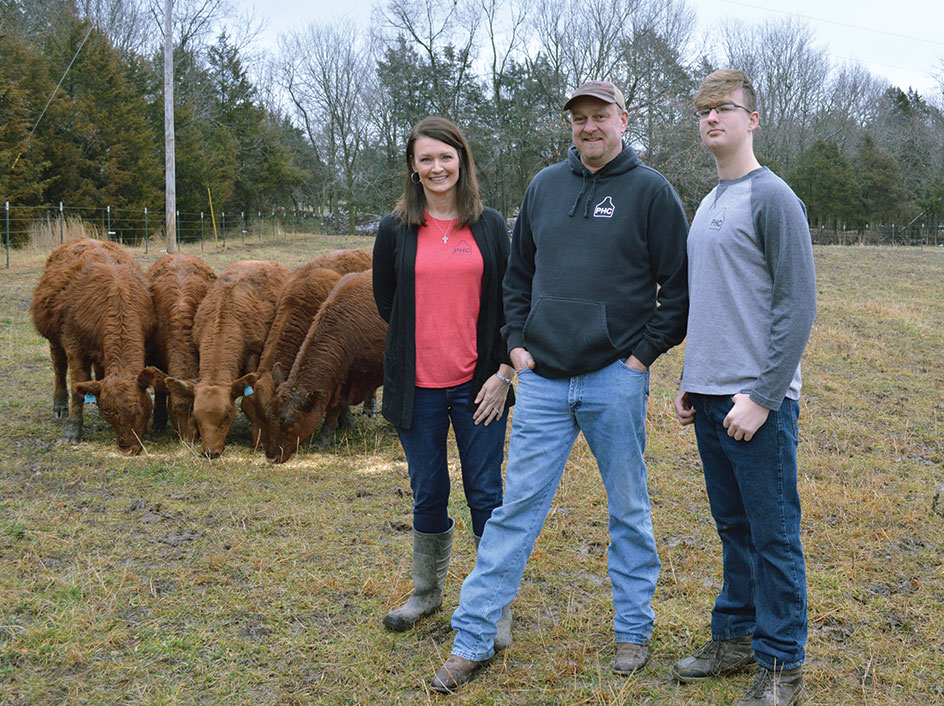
Profitable farming may soon be an oxymoron like the phrase ‘honest politicians,’ but for Kevin and Toni Beatty of Thousand Oaks Ranch in Carl Junction, Mo., agriculture has turned into a booming business. In what some would say is a daring total conversion from bovines to ovines, the Beattys dumped their Limousin cattle for the greener pastures afforded to them by Katahdin sheep.
“We had 40 head but not enough to make it worth the cost associated with having beef cattle,” said Kevin. The search was on for something that would work for them rather than the other way around.
Toni hit the information highway and came across the Katahdin sheep. That was eight years ago with an initial herd of only 30 head of the Katahdins. It has been a positive experience for the Beatty family growing the herd to 450 head today for meat and breeding stock.
Noting what made the decision easy for them Kevin said, “They’re easy to upkeep and are excellent mommas and there’s a good market for them. They are the fastest growing sheep breed out there. They’re low maintenance. You don’t have to shear them or dock their tails. They are a hair sheep so at spring time they shed their winter coat and they’re good to go.”
The Thousand Oaks Ranch Katahdins high resistance to heat stress was put to the test in the drought of the past couple of years. “They are very adaptive to their location,” commented Kevin, “I sold a starter flock to a gentleman down in Oklahoma. I talked to him some time later and he said, ‘You’re sheep are so different from other sheep I’ve seen. They’re out there grazing when other breeds are looking for a shade tree.’ I told him that’s what mine have always done too.”
Breeding management plays a key role in maintaining a flourishing herd and taking advantage of a niche market they have dug out for themselves. An early lesson learned by the Beattys was to work with established breeders. “The first thing I would tell anyone is to buy from a reputable person that’s been in the business for a few years,” said Kevin, “Buy them from a farm rather than a sale barn.”
Keeping the breeding cycle on a solid, repeatable schedule targeted for what one’s desired target market should be a priority. Breeding for the Beatty herd takes place around August to hit the targeted lambing cycle from January to early February. “We have all of our lambs in January and February because that’s the slow time for us. We have barn space so we’ll go ahead and lamb in the barn,” explained Toni.
By 10 to 12 weeks the lambs are weaned making them salable by spring. Kevin explained, “We lamb early to take advantage of marketing them early because we get a lot of people that call wanting lambs early. That way we have a nice sized animal by that time.”
His wife added, “We started selling to the ethnic markets and stopped taking them to the sale barn and going direct market.” Word-of-mouth followed by credentials backing up praise for their product is the Beatty’s double-threat approach to marketing their Katahdins. By exhibiting their sheep in shows in many states around the country, this facet of marketing boosted their visibility and credibility.
The Beattys’ sheep are not just another group of pretty faces all dressed up for show. “They are top breeding animal that anyone would be looking for with good level back, nice rump, straight legs and a good head,” explained Kevin, “That’s what they look for in the show ring too. The shows have been good for us to sell animals because we end up with reserve or grand reserve animals. That helps real well.”
Showing sheep has become the family event that has helped not just the business but helped the family grow closer and give their sons expanded social and learning opportunities they might not experience in certain school activities.
“I think one of the big things is showing because our kids are very active in 4-H,” said Toni, “We go to the shows in Louisville, Kentucky, or Arkansas or Kansas so our kids have made friends in many different states and got to meet a variety of people. They look forward to going to these fairs and it’s that one time during the year they can see those friends. It’s something we do as a family.”
The idea of jumping into unknown waters by anyone without experience in raising sheep can be a little daunting. Even though Kevin has 40 years of agriculture experience, outside help was needed and easily found by talking to other sheep owners. Today they are paying it forward by giving back to those who are coming into the world of Katahdins.
“We try to be a good resource for people and get them up to speed on taking care of sheep,” he said. “People just like us that were in the cattle business, but when it comes to sheep it is alien to them. We try to be a good resource stop for them. Teach them about the problem areas and we try to keep people from running into the same pitfalls we’ve run into.”







